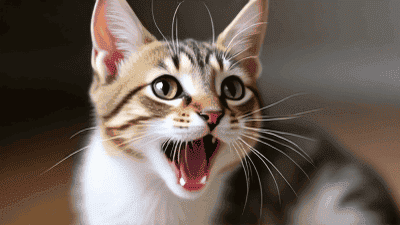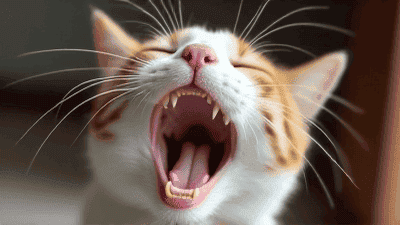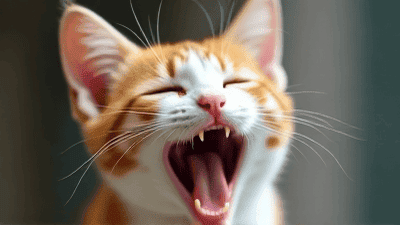
Cats are known for their enigmatic nature, but one of the most common ways they communicate with us is through meowing. Whether it’s a soft purr or a loud yowl, each meow carries a unique message. Understanding why cats meow and what they’re trying to tell us can significantly strengthen the bond between you and your feline friend.
Unlike wild cats, domestic cats primarily meow to communicate with humans rather than other cats. This behavior is believed to have developed as a way for cats to interact with their human companions.
Cats often meow to get your attention, whether they’re hungry, lonely, or simply want to play.
Meowing can be a way for cats to express their needs, such as food, water, or access to a litter box.
Some cats meow to greet their owners or show affection. These meows are usually soft and accompanied by purring or rubbing against your legs.
Excessive meowing can be a sign of stress, anxiety, or underlying health issues. If your cat’s behavior changes suddenly, it’s worth investigating the cause.

One of the most common reasons cats meow is to let you know they’re hungry. If your cat meows around mealtime, they’re likely reminding you to fill their bowl.
Cats are social creatures and may meow if they’re feeling lonely or bored. This is especially common in single-cat households.
Changes in the environment, such as moving to a new home or introducing a new pet, can cause stress and lead to excessive meowing.
Older cats may meow more due to cognitive decline or health issues such as arthritis or hearing loss.
Unspayed or unneutered cats may meow excessively during mating season to attract a partner.

Pay attention to the context of the meow. Is your cat hungry, bored, or stressed? Understanding the reason behind the meow will help you respond appropriately.
If your cat is meowing for food, water, or attention, make sure their needs are met. Stick to a consistent routine to reduce anxiety.
If your cat meows for attention and you respond every time, they may learn that meowing gets them what they want. Instead, reward quiet behavior with treats or affection.
Provide toys, scratching posts, and interactive playtime to keep your cat entertained and reduce boredom-related meowing.
Excessive meowing can be a sign of underlying health problems, such as hyperthyroidism, dental pain, or kidney disease. If your cat’s meowing is accompanied by other symptoms like weight loss or lethargy, consult your veterinarian.
Older cats may meow more due to cognitive dysfunction syndrome (CDS), which is similar to Alzheimer’s in humans. Your vet can recommend treatments or strategies to manage this condition.
Changes in the household, such as a new pet or a move, can cause stress and lead to excessive meowing. Provide a safe, quiet space for your cat and consider using calming products like pheromone diffusers.

Cats thrive on routine. Feed them at the same time each day and provide regular playtime to reduce anxiety and attention-seeking meows.
Keep your cat mentally engaged with puzzle toys, window perches, and interactive games. A stimulated cat is less likely to meow out of boredom.
Use positive reinforcement to teach your cat quiet behaviors. Reward them with treats or affection when they’re calm and quiet.
If your cat is lonely, consider adopting a second cat to keep them company. Ensure proper introductions to avoid stress.
Some cats open their mouths as if to meow but no sound comes out. This is known as a silent meow.
Silent meows are often a sign of affection or a way to communicate quietly. Some cats use silent meows to greet their owners or express contentment.
Cats communicate through body language, including tail position, ear movement, and facial expressions. Understanding these cues can help you interpret your cat’s feelings.
Purring is often a sign of contentment, but cats may also purr when they’re in pain or anxious. Pay attention to the context to understand what your cat is trying to convey.
These sounds indicate fear, aggression, or a warning to back off. If your cat hisses or growls, give them space and avoid provoking them.
A wagging tail doesn’t always mean happiness. A flicking or lashing tail can indicate irritation, while a puffed-up tail signals fear or aggression.
Engage in activities your cat enjoys, such as grooming, playing, or cuddling. This will help build trust and strengthen your bond.
Every cat is unique. Pay attention to your cat’s likes and dislikes to create a comfortable and happy environment for them.
Building a strong relationship with your cat takes time. Be patient and allow your cat to come to you on their terms.
Cats are fascinating creatures with a wide range of vocalizations and behaviors. By understanding why cats meow and what they’re trying to communicate, you can respond to their needs effectively and strengthen your bond. Whether your cat is meowing for food, attention, or out of stress, being attentive and proactive will ensure they feel loved and understood. Remember, excessive or unusual meowing may indicate an underlying issue, so always consult your veterinarian if you have concerns. With patience and care, you and your feline friend can enjoy a harmonious and fulfilling relationship.